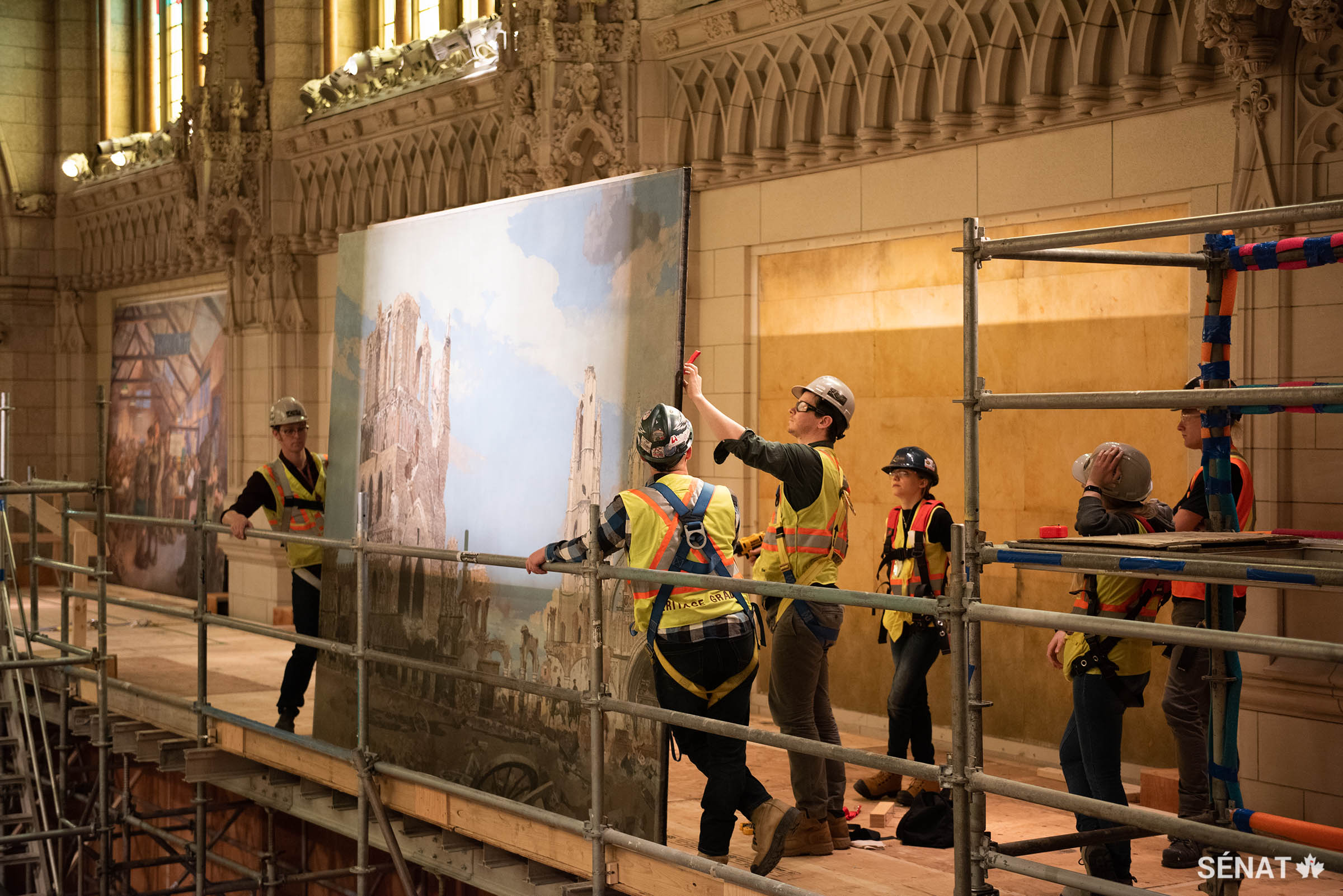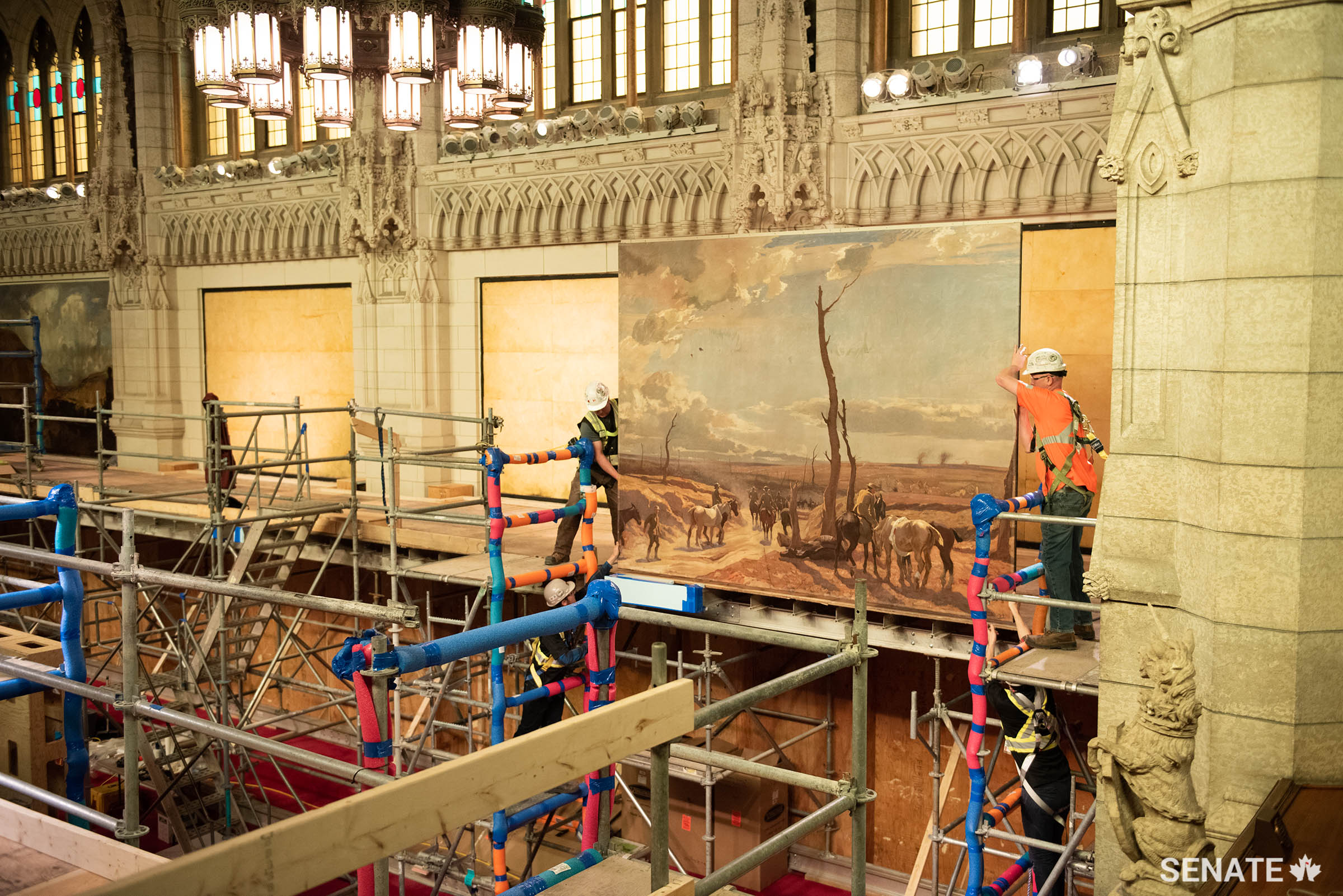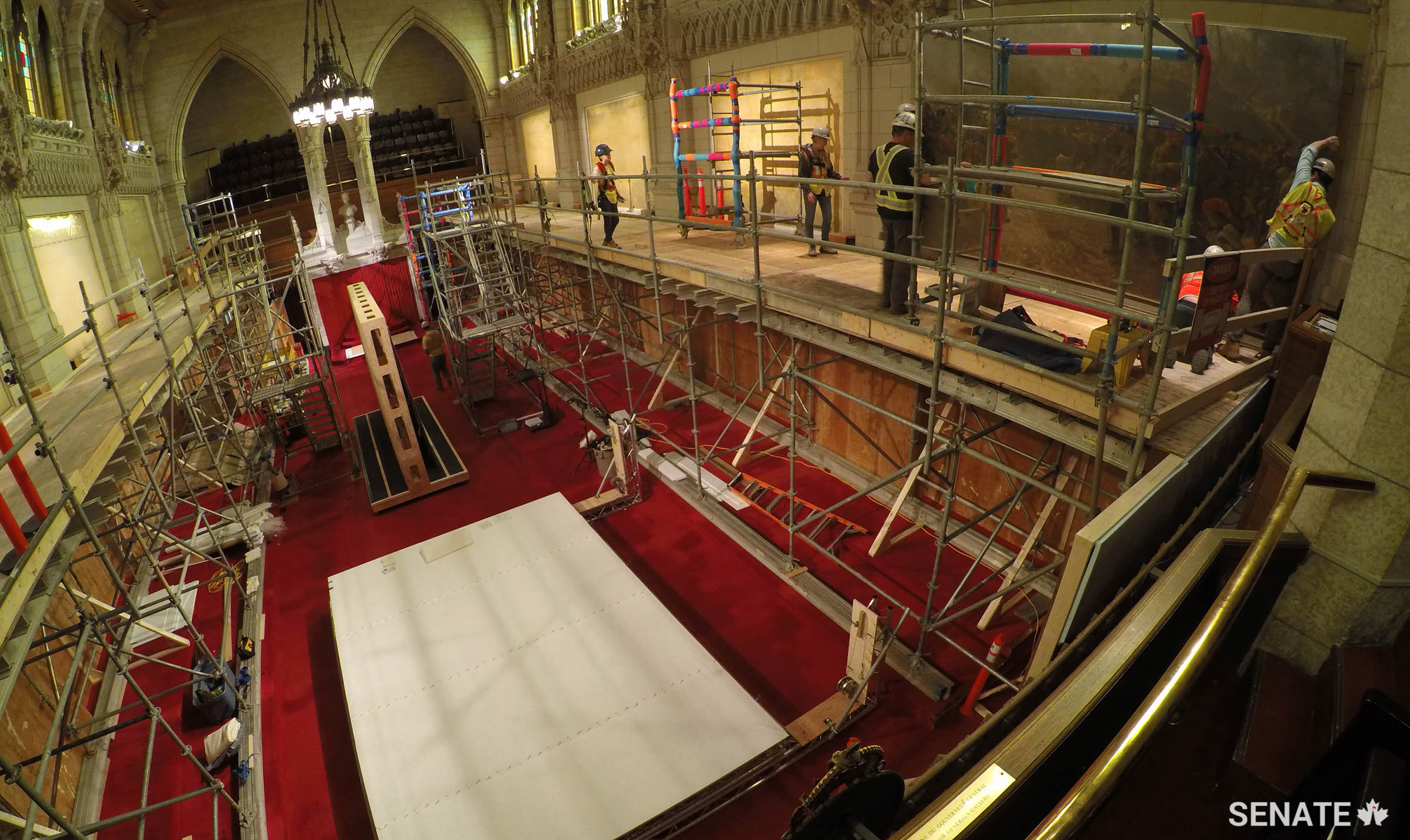Preserving the past: Conservators crate up historic war paintings in the Senate Chamber

The Senate Chamber in Centre Block is normally bustling with clerks, pages and senators and echoing with debate. But in May and June 2019, it was crammed with scaffolds, hoists and enormous easels. It looked like Leonardo da Vinci’s workshop, not Canada’s Upper House of Parliament.
Eight monumental war paintings have been carefully removed from the Senate’s permanent home in Centre Block as part of the rehabilitation of Parliament Hill. (The Senate Chamber itself has moved into what is now the Senate of Canada Building — a former train station built in downtown Ottawa in 1912.)
These depictions of the First World War had hung there since 1921, initially under an arrangement with the National Gallery of Canada then, when custodianship of the paintings transferred in 1971, with the Canadian War Museum. They will move to the museum and remain there for the duration of Centre Block repairs, a project expected to take at least a decade.
The scenes include the first landing of Canadian soldiers in France, ruined towns on the Western Front, weary soldiers on leave as well as refugees returning to destroyed homes.
The paintings are part of a collection of nearly 1,000 works commissioned by the Canadian War Memorials Fund, the brainchild of Max Aitken, the New Brunswick-raised media baron who was awarded the title Lord Beaverbrook in 1917.
The fund, Canada’s first official war-art program, dispatched artists and photographers to the Western Front to capture the stories of the 425,000 Canadians who fought on battlefronts whose names are now familiar to Canadians, among them Ypres, The Somme, Vimy Ridge and Passchendaele.
In 1921, Parliament asked to hang some of the paintings in Centre Block. They have remained here ever since, a pictorial tribute to the heroism and sacrifice of Canadians in the “war to end all wars.”
The Senate’s Artwork Advisory Working Group, made up of senators Patricia Bovey, Nicole Eaton and Serge Joyal, has overseen the collection’s move.
“These paintings are important Canadian treasures, central to Canadian history and from the time when Canada came of age as a nation,” said Senator Bovey, an art historian and former director of the Winnipeg Art Gallery. “They are likewise central to the Senate and I am pleased that the Senate, the Canadian Conservation Institute, the Canadian War Museum and conservation professionals are working in partnership to preserve this part of our patrimony.”
“These paintings speak to the sacrifices of Canadians in the First World War – to unsung heroes like the veterinary corps, the engineers and the rank-and-file soldiers, among those who should have their voice heard in the Senate,” said Senator Joyal, a historian and art collector. “They speak to the concepts of duty, service and sacrifice.”
Because of their age and size — more than three metres wide and two metres high — the canvases presented a particular challenge to the specialists from Ottawa-based Legris Conservation tasked with their move.
“These canvases have hung here for nearly a century,” said conservator David Legris. “Not surprisingly they’re somewhat brittle. We have to be painstaking. That’s why we’ve budgeted eight weeks to complete the job — roughly four days per painting.”
The procedure begins with a “full condition report” where conservators assess each painting for everything from discoloured varnish to cracks in the paint layer to the integrity of the canvas support.
Next, they perform “minor consolidation” — small repairs to secure the paintings for removal.
“We stabilize paint that’s raised or flaking,” said Mr. Legris. “We’ll apply Japanese tissue, a thin paper that holds any weakened areas in place.”
Each painting is unscrewed from its mounting brackets, lowered on a scaffold, then mounted upright on a large rolling easel to be photographed for archival purposes.
The painting’s surface is covered with a sheet of protective mylar as it is transferred to a folding table, a custom-built cable-and-winch structure that slowly lowers the upright painting until it lies horizontally, protected face down.
The painting is detached from its stretcher – the framework that holds the canvas taut — then rolled around a Sonotube, a hollow cardboard spool nearly a metre across that allows the painting to be packed as loosely as possible to avoid cracking the paint surface.
The entire roll is wrapped in a durable protective film called Tyvek – the same material used to wrap houses under construction – followed by an outer layer of polyester-cotton fabric.
The Sonotube’s hollow core is reinforced with four plywood discs threaded along an aluminum rod. This rod is both the handle by which the 70 kg cargo is carried out of the Chamber and the crossbar by which it is supported in storage.
“Once the painting is on the roll it always has to be suspended horizontally,” said Mr. Legris. “It can’t be set down because of the weight.”
Inside the transport truck, the painting is supported within a custom-built transportation crate and shipped to the Canadian War Museum.
The eight paintings are now securely in storage where they will eventually undergo a second, more detailed assessment. This analysis may take months and will determine the extent of conservation work that needs to be done. At that point, the museum will tender the contract for restoration work.
Senator Eaton, for one, is happy the move unfolded as smoothly as it did.
“These paintings are national treasures,” she said. “It’s reassuring to see the Senate and its partners taking such incredible care in preserving our Canadian heritage.”
Although Centre Block was shuttered for rehabilitation work, Canadians can still experience its art and architecture through the Senate’s immersive virtual tour.
 Conservators remove the painting The Watch on the Rhine (The Last Phase) (1920), by British artist Sir William Rothenstein, from the walls of the Senate Chamber. Eight historic First World War paintings were moved to the Canadian War Museum in May and June 2019 as part of Centre Block’s rehabilitation. (CWM 19710261-0601, Beaverbrook Collection of War Art, Canadian War Museum)
Conservators remove the painting The Watch on the Rhine (The Last Phase) (1920), by British artist Sir William Rothenstein, from the walls of the Senate Chamber. Eight historic First World War paintings were moved to the Canadian War Museum in May and June 2019 as part of Centre Block’s rehabilitation. (CWM 19710261-0601, Beaverbrook Collection of War Art, Canadian War Museum)
 As James Kerr-Lawson’s The Cloth Hall, Ypres (1919) comes down, it reveals the enclosure built for it. To create the illusion of stone surrounds, custom niches were constructed for each painting, bordered with faux-limestone walls made from fabric textured with stucco and paint. These enclosures also gave the differently sized paintings the illusion of uniformity. (CWM 19710261-0334, Beaverbrook Collection of War Art, Canadian War Museum)
As James Kerr-Lawson’s The Cloth Hall, Ypres (1919) comes down, it reveals the enclosure built for it. To create the illusion of stone surrounds, custom niches were constructed for each painting, bordered with faux-limestone walls made from fabric textured with stucco and paint. These enclosures also gave the differently sized paintings the illusion of uniformity. (CWM 19710261-0334, Beaverbrook Collection of War Art, Canadian War Museum)
 Conservators lower Algernon Talmage’s A Mobile Veterinary Unit in France (1917) to the floor of the Senate Chamber. Each of the eight paintings weighs approximately 70 kg and required six handlers. (CWM 19710261-0596, Beaverbrook Collection of War Art, Canadian War Museum)
Conservators lower Algernon Talmage’s A Mobile Veterinary Unit in France (1917) to the floor of the Senate Chamber. Each of the eight paintings weighs approximately 70 kg and required six handlers. (CWM 19710261-0596, Beaverbrook Collection of War Art, Canadian War Museum)
 For eight weeks in May and June 2019, the Senate Chamber was transformed into a workshop. Scaffolds, stands and lowering tables were assembled on the Chamber floor to help conservators safely lower and pack the eight war paintings.
For eight weeks in May and June 2019, the Senate Chamber was transformed into a workshop. Scaffolds, stands and lowering tables were assembled on the Chamber floor to help conservators safely lower and pack the eight war paintings.


